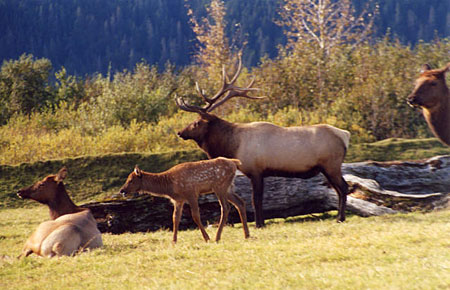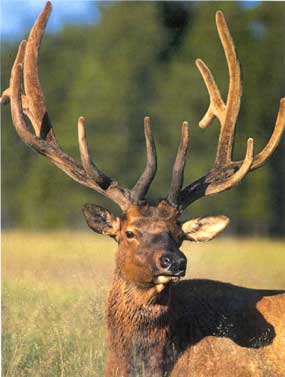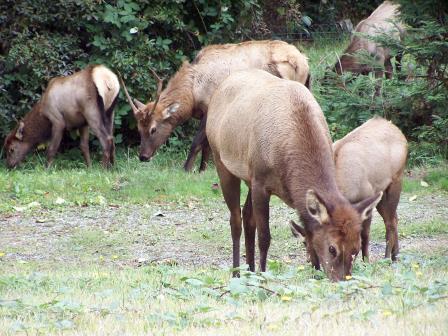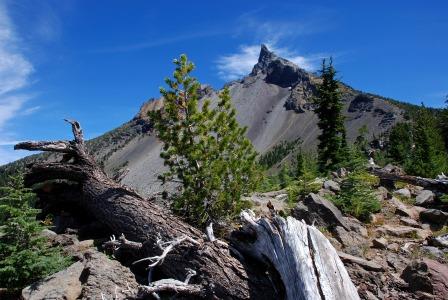
By Taylor Rudow, Oregon Wild intern
Nothing can prepare you for the first time you see Roosevelt Elk in the wild. As the largest variety of elk in North America, they tower above you. Mature bulls with full antlers included can easily exceed ten feet in height and length. While they are a force to be reckoned with, you cannot help but to stop and appreciate their majesty. In the winter thick black fur rings their necks, standing in sharp contrast to their light brown bodies and beige rumps. In the spring, their coats are equally stunning, with their brown and black fur being replaced by a striking red and brown array. In the bull elk, these coats are accented by magnificent antlers, which grow five feet in length and end in a three-point tip like crowns upon their heads.

Elk start their lives in isolation. Before a female elk gives birth, she leaves her herd and ventures out on her own to select a birthing place. Because large groups of elk are easy to spot, cows will avoid the herd until their calves are large enough to run away from predators. Therefore, for the first two weeks of life, the gangling 35 pound calves are reliant on their mothers to hide them from attacks.
However, it is not long before the calves are big enough to join the herd. During most of the year herds are made up of only cows and calves, giving the young adults plenty of moms and friends to grow around. By the end of summer, the once-small calves are 250 pounds and already gaining their new adult coats.
The calves then begin a lifecycle that has been repeated annually in Oregon for decades. Females spend their years in harems, seasonally migrating between the Cascade Mountain Range in the summer months and forest areas closer to the coast in the winter months. Males follow a similar migration pattern, though theirs happens on their own, away from the harems.
While the Roosevelt Elk o nce followed this migration from the Cascades to the Pacific Coast, the advance of civilization caused the elk to withdraw to higher elevations. By 1917 human progression, along with avid hunting, had forced the elk that resided in Crater Lake National Park to the brink of extinction. In an attempt to save the species, fifteen Rocky Mountain elk were relocated from Yellowstone. Though this transplant saved the Crater Lake elk population from destruction, it also created offspring that were a subspecies born of the combination of the two breeds. Today, elk in the area still struggle to survive. Two small herds, totaling roughly 200 animals, call the Crater Lake National Park their summer home. However destructive human involvement has these fragile populations at risk.
nce followed this migration from the Cascades to the Pacific Coast, the advance of civilization caused the elk to withdraw to higher elevations. By 1917 human progression, along with avid hunting, had forced the elk that resided in Crater Lake National Park to the brink of extinction. In an attempt to save the species, fifteen Rocky Mountain elk were relocated from Yellowstone. Though this transplant saved the Crater Lake elk population from destruction, it also created offspring that were a subspecies born of the combination of the two breeds. Today, elk in the area still struggle to survive. Two small herds, totaling roughly 200 animals, call the Crater Lake National Park their summer home. However destructive human involvement has these fragile populations at risk.
Elk play an important part in the wilderness ecosystem. Because they are herbivores elk help to clear understory vegetation in the forest, making way for other plants and animals. Currently habitat loss and fragmentation due to harmful human practices, such as logging and road construction, threaten these unique elk. Forest management techniques such as clear-cutting and monoculture replanting have also harmed the elk population because the lack of sunlight keeps the understory, their primary food source, from growing.
Though elk populations are being threatened there are not many official plans in place to protect them. Therefore, if we are to keep this delicate population from once again reaching the brink of disaster, it is important to protect the pristine forests they require for habitat and migration. Fortunately, Oregon Wild is working to protect the backcountry in and around Crater Lake National Park, which would provide elk with safe migratory pathways and consistent food supplies in the summer. Elk have fought hard for their right to live in Oregon - it is important that we let them live unhindered.


